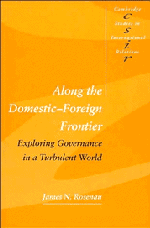Book contents
- Frontmatter
- Contents
- List of figures and tables
- Preface
- Acknowledgments
- Part I Intellectual contexts
- Part II Global contexts
- Part III Societal contexts
- Part IV Actors
- 14 Individuals
- 15 Publics
- 16 Leaders
- 17 Organizations
- 18 States
- 19 Militaries
- 20 The United Nations
- Part V Conclusions
- Epilogue
- Index
- CAMBRIDGE STUDIES IN INTERNATIONAL RELATIONS
15 - Publics
Published online by Cambridge University Press: 19 January 2010
- Frontmatter
- Contents
- List of figures and tables
- Preface
- Acknowledgments
- Part I Intellectual contexts
- Part II Global contexts
- Part III Societal contexts
- Part IV Actors
- 14 Individuals
- 15 Publics
- 16 Leaders
- 17 Organizations
- 18 States
- 19 Militaries
- 20 The United Nations
- Part V Conclusions
- Epilogue
- Index
- CAMBRIDGE STUDIES IN INTERNATIONAL RELATIONS
Summary
For a moment, [the leaders were caught by surprise. They] were not so much leaders as followers of a process of social combustion that raced forward spontaneously and uncontrollably: first came the mass movement; then came the demands and the negotiations … Suddenly, there was a power in society where none was supposed to be … Right in the heart of a totalitarian system, under which people are supposed to be at their most helpless, Solidarity gave the world one of the most startling demonstrations of the power of the people that it has ever seen.
While it is hardly surprising that the fast pace of the skill revolution, the spread of authority crises, the emergence of the multi-centric world, and the further quickening of these patterns by the events surrounding the end of the Cold War have upended citizens everywhere, leading many into restructuring their self–environment orientations, it is less clear how and why these dynamics have resulted in the formation of publics capable of toppling governments or otherwise effecting change. Individuals are restless, their loyalties are in flux; their inclinations to shift to apathetic, self-centered, ideological, or democratic forms of citizenship have been intensified; but how and why these tendencies among individuals have been transformed into spontaneous and effective publics is not easily explained. How and why, for example, did the collapse of communism in the Soviet Union and the end of apartheid in South Africa occur so quickly, so thoroughly, and so successfully in the late 1980s and early 1990s?
- Type
- Chapter
- Information
- Along the Domestic-Foreign FrontierExploring Governance in a Turbulent World, pp. 299 - 310Publisher: Cambridge University PressPrint publication year: 1997

